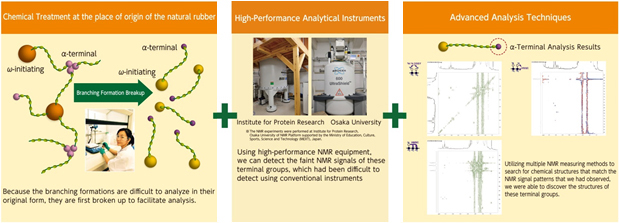| |
SRI Reports on Results of Our Research on the Analysis of the Terminal Group Structures of Natural Rubber
|
| |
Sumitomo Rubber Industries, Ltd. is pleased to announce that we have reported on the results of our groundbreaking research on the molecular structural analysis of natural rubber from Para rubber trees at the International Rubber Conference (IRC) 2016 Kitakyushu.*1 Utilizing extremely high-performance NMR*2 equipment, our proprietary analysis techniques have enabled us to analyze the terminal group structures of natural rubber, which have never before been elucidated in detail. Thanks to the results of this research, we can anticipate significant improvements in the performance and processability of natural rubber, opening up new possibilities for enhanced tire performance in terms of fuel efficiency and wear resistance.
*1: The IRC is an annual conference that brings together researchers in the rubber and elastomer field from around the world with the aim of promoting the international exchange of ideas as the first step toward furthering scientific progress and technological development.
*2: Nuclear Magnetic Resonance
Having established VISION 2020, our long-term vision laying out what the Sumitomo Rubber Group hopes to accomplish by the year 2020, we have been taking on various New Challenges toward the achievement of our goals, driven by the three key Growth Engines that we defined in VISION 2020: the "Challenges of New Markets," an "Insatiable Drive for Innovation" and "Entering New Business Fields." As part of our "Insatiable Drive for Innovation," we have been actively engaged in new product development that aims to answer the question: "What can tires contribute to the global environment?" with a focus on three key areas of environmentally friendly product development-Fuel Efficiency, Raw Materials and Resource Savings. The results of this recent research are among the many fruits brought about through our ongoing efforts in terms of new materials development technology.
|
| |
| [Objectives]
Natural rubber, one of the major raw materials in tires since their advent, is an agricultural product that is typically harvested from Para rubber trees (Hevea brasiliensis). Although the molecular structure of natural rubber has long been assumed to have branching formations that affect the properties of the rubber, the detailed structures of the terminal groups ( -initiating, -initiating,  -terminal) that form these branching formations have remained shrouded in mystery until now. -terminal) that form these branching formations have remained shrouded in mystery until now. |
| |
|  |
| |
[Methodology]
Thanks to an advanced process that involves chemically treating natural rubber at its place of origin and the utilization of the extremely high-performance NMR equipment*3 at Osaka University, we have succeeded in detecting the faint NMR signals of these terminal groups, which cannot be detected using conventional analytical instruments. Further, by utilizing multiple NMR measuring methods in our analysis, we were able to conduct a search for chemical structures that matched the NMR signal patterns that we had observed, thus enabling us to discover the actual structures of these terminal groups.
*3: The NMR measurements used in this research were performed at the Institute for Protein Research, Osaka University, a facility participating in the "NMR Platform," which is a program initiated by the Japanese Ministry of Education, Culture, Sports, Science and Technology to promote the sharing of advanced research facilities.
|
|  |
| |
[Conclusions]
We have discovered that the  -initiating terminals of natural rubber molecules are dimethyl allyl groups while the -initiating terminals of natural rubber molecules are dimethyl allyl groups while the  -terminals are a mix of four different types of structures. Further, we have found that two of these structures directly contribute to branching formations as well as gel formation. -terminals are a mix of four different types of structures. Further, we have found that two of these structures directly contribute to branching formations as well as gel formation.
We have gained the ability to begin unraveling the mysteries surrounding the branching formations of natural rubber by analyzing the structures of their terminal groups, thus opening up numerous new possibilities for improving the performance and processability of natural rubber in order to achieve greater enhancements in the fuel efficiency and wear resistance performance of tires. In addition, by further elucidating the mechanisms behind the superior performance traits that are innate to natural rubber based on the results of our structural analysis, we will be able to apply this knowledge to the development of entirely new materials.
|
|
| |

|
|